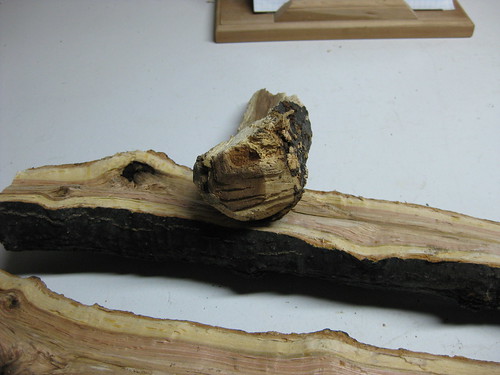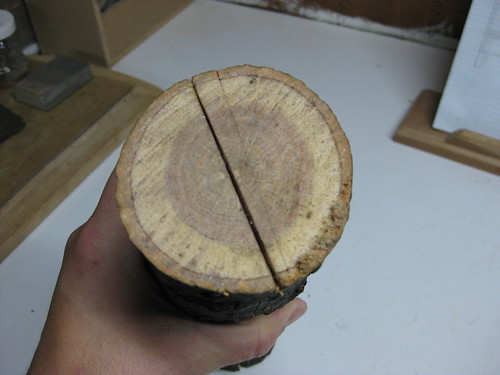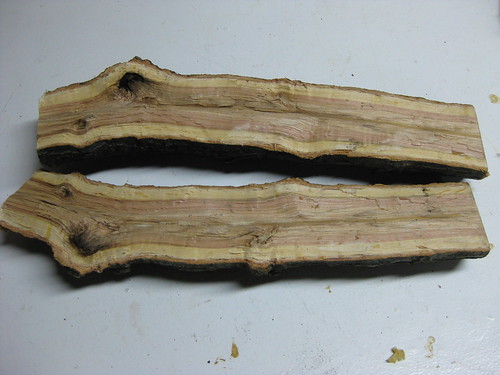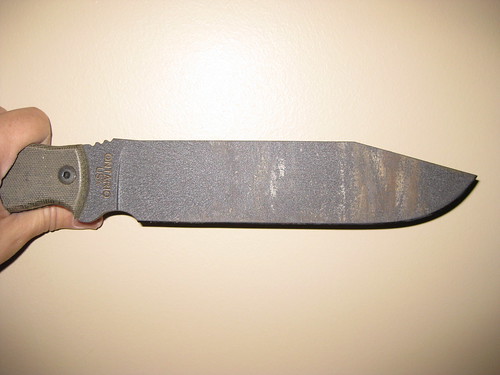OKC Ranger Bush Series RD-7 Review
NOTE: I am not going to review the RD-7 in sense of applying the 20 point scale. I haven't owned enough fixed blade knives (two exactly, a Cold Steel Recon Tanto in college and the RD-7) to know what to look for in a bunch of specific criteria. Instead, I am going to give you my feedback on the knife in a more free form way.
About a month before my RD-7 arrived New England was hit with a bizarre October snowstorm. The storm dumped about a foot of thick, wet heavy snow around my house bending a few branches and breaking some more. We cleaned up, but it was the spur for me to get serious about a survival pack. I wanted to have the pack equipped with a large knife. The research I did was subject of three articles, the "Going Through the Process" series, found here, here, and here. After the snowstorm we had some of the trees trimmed back and the remainders were left on the front yard for me to deal with. I have a pretty nice axe and a stump to split wood on along with a very good system for processing wood, but the RD-7 came along for some chopping and testing.
For a bit of explanation I am going to go a little wood nerd on you, but just a little. All the wood I cut was green (as in "freshly cut") red oak that had been cut from the tree two days before my testing. I processed it for firewood to use in the fireplace we have on the first floor of my house. Red oak, if you don't already know, is a tough, open grain hardwood with a very high specific gravity (kiln dried it is .71, wet it is .95, yikes!). Many of the YouTube videos that show people splitting or chopping wood with a knife show them using lesser woods, evergreens, poplar, and the like (the linked video looks like dry pine, which is practically styrofoam when compared to wet red oak). These are good tests, no doubt, but oak, especially wet oak is a brutal test on a knife. Among common North American hardwoods only hickory is a better (i.e. more challenging) test. Oak has two things going for it--first, it is very dense (as you can see by the measure of specific gravity, which is not density per se, but a good approximation of it). Second, it is very fibrous. Think of it like this: a potato and a steak may have a similar density, but the muscle fibers in the steak make tearing it apart to eat it more difficult than tearing apart the potato. Oak is like a very stringy piece of beef while pine, poplar, and even the very dense maple are close grain woods and thus more like a potato. This is a long way of saying that red oak is a very good testing medium. It is not terribly practical because you are never going to try to tackle an oak with just a knife in the wilderness, they are just too big and too tough, but I figured if the RD-7 could handle very green oak, it could handle most anything else.
Here is the product page, though I will forewarn you: it is terrible. OKC's entire site is disorganized, hard to use, an uninformative. The specs don't even include the blade steel. The Knifecenter page (next link) is better and the steel appears to be 5160. I paid $49.95 plus shipping for my RD-7. Unfortunately, the Black Friday Special sale price is significantly lower than the next closest price now. Here is a representative street price (even thefind.com could find nothing cheaper than $88). There are no reviews, written or video, that I could find, but here is some good feedback on knifeforum. I got my RD-7 at Chestnut Ridge Knife Shop and it was a great transaction--fast and easy to make online.
The knife is large and solid in the hand, with 3/16" thick 5160 steel, a 7.5" blade and a 5" handle. It is full flat ground (yipee!). The knife is a full tang knife with a tang pommel. The micarta scales are nicely finished, though I noticed they were flush with the top of the tang, but not the bottom (not that the bottom matters all that much). They are also a bit square. The sheath is a nylon sheath with a plastic scabbard insert. It is MOLLE compatible, but not all of that good at retaining the knife. The knife can and does move around a good bit. I may upgrade to a custom sheath, maybe even one from Chestnut Ridge, down the line. Mine was gray powder coated and the coating was even and nice. The edge was surprisingly immaculate given the knife's role as a chopper, and was razor sharp. It could push cut paper when I received it.
My first test was to cut a dead branch off of a larger limb. The branch was dry and around 2-2.5" thick. I used alternate direction swings while chopping and the knife produced what could only be described as a fountain of wood chips. The limb came off in about a minute. The knife did produce a few hot spots on the hand, especially on the top of the handle slabs as they are, as mentioned before, a bit square. Here is the result of the chopping test:
The limb was completely severed and the chip shower produced a lot of good kindling pieces. Here the weight of the blade, which is quite substantial, really helped power the cuts. Switching directions and taking an aggressive hack was easy. Overall, very good at chopping. And since that was the reason I originally bought the knife, I am pleased with the purchase.
After the chopping test, I decided to try batoning the knife through a more substantial piece of wood around 3.5" in diameter. I cut it into a manageable 18" long piece with a bow saw. Here is a good shot of the wood put back together to demonstrate its size.
If that is the "before" then here is the "after":
There is significant debate over the utility of batoning wood. Whatever side you fall on, however, it cannot be ignored as a way to stress test a fixed blade knife. I set the blade into the top of the log with a gentle swing. A few knocks from another piece of wood put the RD-7 deep into the log. After I pushed the blade spine below the surface of the log I used the protruding portion of the blade to continue the process. I took probably ten or fifteen whacks, a few on the handle side, but the majority on the tip side, and the wood came apart. The knot you see above was probably 80% of the work. Overall, batoning is slow compared to splitting wood with an axe or a maul. Over the years I have become pretty decent at splitting wood, not like "North Woods Lumberjack" good, but I can split just about any piece under 8" in diameter with one or two swings. I would have probably split 5 to 8 pieces of wood in the time it took me to baton this one piece.
Here is my take on batoning. Batoning is convenient. You can do it in a smaller space. It takes less skill and effort. You are less likely to injure yourself with an axe deflection or flying piece of wood. It also allows you to tackle smaller pieces of wood, which is an advantage. It means that you don't have to cut down massive limbs to start a fire of build a shelter. With an axe, at least at my skill level, a piece smaller than 2" in diameter is hard to split, but when batoning that is no problem. I think batoning is a valuable skill to have, but not an essential one. I like the ease, lack of skill, and low energy exertion of the process compared to splitting wood with an axe. I also like the ability to process less than ideal sizes of wood. Finally, an axe or maul is not a practical tool to carry with you in a survival pack while a knife the size of the RD-7 is perfect for such a kit.
The RD-7 handled this test with ease. The blade sunk into the wood and I could hear cracks and snaps as the limb's internal tension was released by the splitting action of the RD-7's blade. I would have taken another inch or two on the blade to make strikes easier, but it was not a big issue. Again, the weight of the blade helped out tremendously.
Batoning wet red oak is brutal on the edge of the knife. After chopping, the edge was fine. Not pushing paper sharp, but still fine. After batoning though, it was all but done. The middle portion of the blade was dull while the tip and the portion near the handle were sharp. Fortunately 5160 steel sharpens easily and a few strokes on the Sharpmaker brought it back to a razor's edge.
The knife performed very, very well. After sharpening it I gave a bath in WD-40 and cleaned it up. There was no chipping of the secondary bevel. The coating is still entirely intact though a bit discolored. The handles are nice, but a bit square. The size, weight, and shape of the blade are excellent. When batoning I would opt for a slightly longer blade than 7.5" but it is still plenty long and anything longer is more of hassle to carry. The knife is big enough to do a lot of things and still small enough to control in precision cuts.
At $49.95 this knife is a shockingly good value. It feels like larceny. Unfortunately, that seems like a once a year price. At $88.95 it is still a good deal, but not the screamer it is at the lower price. I would probably opt for a BK-7 if I had to pay full price for this knife. Still, this is a choice between two great blades. As a fixed blade, I am more than pleased with the RD-7. The sheath stinks, but I am not too worried about that as replacements are readily available (for around $45) and it works for my purposes right now. Sanding the handle slabs to be a little rounded would also be good, but that is a matter of preference. Without the twenty point scale to work with I am not sure how to summarize this product. It feels like the same level of quality, design, and fit and finish as a knife I would score as an 18, but that is just a guess and horribly unsystematic.
One caveat though when you buy this knife: the temptation to go on a chopping spree, felling limbs and small trees, is overwhelming and will make you look nuts. I had the excuse of clearing branches to make me look slightly less crazy, but the urge is irresistible and giving in is tremendously fun. I went chopping, slashing, and hacking nuts after the two "formal" tests and it was a blast.
About a month before my RD-7 arrived New England was hit with a bizarre October snowstorm. The storm dumped about a foot of thick, wet heavy snow around my house bending a few branches and breaking some more. We cleaned up, but it was the spur for me to get serious about a survival pack. I wanted to have the pack equipped with a large knife. The research I did was subject of three articles, the "Going Through the Process" series, found here, here, and here. After the snowstorm we had some of the trees trimmed back and the remainders were left on the front yard for me to deal with. I have a pretty nice axe and a stump to split wood on along with a very good system for processing wood, but the RD-7 came along for some chopping and testing.
For a bit of explanation I am going to go a little wood nerd on you, but just a little. All the wood I cut was green (as in "freshly cut") red oak that had been cut from the tree two days before my testing. I processed it for firewood to use in the fireplace we have on the first floor of my house. Red oak, if you don't already know, is a tough, open grain hardwood with a very high specific gravity (kiln dried it is .71, wet it is .95, yikes!). Many of the YouTube videos that show people splitting or chopping wood with a knife show them using lesser woods, evergreens, poplar, and the like (the linked video looks like dry pine, which is practically styrofoam when compared to wet red oak). These are good tests, no doubt, but oak, especially wet oak is a brutal test on a knife. Among common North American hardwoods only hickory is a better (i.e. more challenging) test. Oak has two things going for it--first, it is very dense (as you can see by the measure of specific gravity, which is not density per se, but a good approximation of it). Second, it is very fibrous. Think of it like this: a potato and a steak may have a similar density, but the muscle fibers in the steak make tearing it apart to eat it more difficult than tearing apart the potato. Oak is like a very stringy piece of beef while pine, poplar, and even the very dense maple are close grain woods and thus more like a potato. This is a long way of saying that red oak is a very good testing medium. It is not terribly practical because you are never going to try to tackle an oak with just a knife in the wilderness, they are just too big and too tough, but I figured if the RD-7 could handle very green oak, it could handle most anything else.
Here is the product page, though I will forewarn you: it is terrible. OKC's entire site is disorganized, hard to use, an uninformative. The specs don't even include the blade steel. The Knifecenter page (next link) is better and the steel appears to be 5160. I paid $49.95 plus shipping for my RD-7. Unfortunately, the Black Friday Special sale price is significantly lower than the next closest price now. Here is a representative street price (even thefind.com could find nothing cheaper than $88). There are no reviews, written or video, that I could find, but here is some good feedback on knifeforum. I got my RD-7 at Chestnut Ridge Knife Shop and it was a great transaction--fast and easy to make online.
The knife is large and solid in the hand, with 3/16" thick 5160 steel, a 7.5" blade and a 5" handle. It is full flat ground (yipee!). The knife is a full tang knife with a tang pommel. The micarta scales are nicely finished, though I noticed they were flush with the top of the tang, but not the bottom (not that the bottom matters all that much). They are also a bit square. The sheath is a nylon sheath with a plastic scabbard insert. It is MOLLE compatible, but not all of that good at retaining the knife. The knife can and does move around a good bit. I may upgrade to a custom sheath, maybe even one from Chestnut Ridge, down the line. Mine was gray powder coated and the coating was even and nice. The edge was surprisingly immaculate given the knife's role as a chopper, and was razor sharp. It could push cut paper when I received it.
My first test was to cut a dead branch off of a larger limb. The branch was dry and around 2-2.5" thick. I used alternate direction swings while chopping and the knife produced what could only be described as a fountain of wood chips. The limb came off in about a minute. The knife did produce a few hot spots on the hand, especially on the top of the handle slabs as they are, as mentioned before, a bit square. Here is the result of the chopping test:
The limb was completely severed and the chip shower produced a lot of good kindling pieces. Here the weight of the blade, which is quite substantial, really helped power the cuts. Switching directions and taking an aggressive hack was easy. Overall, very good at chopping. And since that was the reason I originally bought the knife, I am pleased with the purchase.
After the chopping test, I decided to try batoning the knife through a more substantial piece of wood around 3.5" in diameter. I cut it into a manageable 18" long piece with a bow saw. Here is a good shot of the wood put back together to demonstrate its size.
If that is the "before" then here is the "after":
There is significant debate over the utility of batoning wood. Whatever side you fall on, however, it cannot be ignored as a way to stress test a fixed blade knife. I set the blade into the top of the log with a gentle swing. A few knocks from another piece of wood put the RD-7 deep into the log. After I pushed the blade spine below the surface of the log I used the protruding portion of the blade to continue the process. I took probably ten or fifteen whacks, a few on the handle side, but the majority on the tip side, and the wood came apart. The knot you see above was probably 80% of the work. Overall, batoning is slow compared to splitting wood with an axe or a maul. Over the years I have become pretty decent at splitting wood, not like "North Woods Lumberjack" good, but I can split just about any piece under 8" in diameter with one or two swings. I would have probably split 5 to 8 pieces of wood in the time it took me to baton this one piece.
Here is my take on batoning. Batoning is convenient. You can do it in a smaller space. It takes less skill and effort. You are less likely to injure yourself with an axe deflection or flying piece of wood. It also allows you to tackle smaller pieces of wood, which is an advantage. It means that you don't have to cut down massive limbs to start a fire of build a shelter. With an axe, at least at my skill level, a piece smaller than 2" in diameter is hard to split, but when batoning that is no problem. I think batoning is a valuable skill to have, but not an essential one. I like the ease, lack of skill, and low energy exertion of the process compared to splitting wood with an axe. I also like the ability to process less than ideal sizes of wood. Finally, an axe or maul is not a practical tool to carry with you in a survival pack while a knife the size of the RD-7 is perfect for such a kit.
The RD-7 handled this test with ease. The blade sunk into the wood and I could hear cracks and snaps as the limb's internal tension was released by the splitting action of the RD-7's blade. I would have taken another inch or two on the blade to make strikes easier, but it was not a big issue. Again, the weight of the blade helped out tremendously.
Batoning wet red oak is brutal on the edge of the knife. After chopping, the edge was fine. Not pushing paper sharp, but still fine. After batoning though, it was all but done. The middle portion of the blade was dull while the tip and the portion near the handle were sharp. Fortunately 5160 steel sharpens easily and a few strokes on the Sharpmaker brought it back to a razor's edge.
The knife performed very, very well. After sharpening it I gave a bath in WD-40 and cleaned it up. There was no chipping of the secondary bevel. The coating is still entirely intact though a bit discolored. The handles are nice, but a bit square. The size, weight, and shape of the blade are excellent. When batoning I would opt for a slightly longer blade than 7.5" but it is still plenty long and anything longer is more of hassle to carry. The knife is big enough to do a lot of things and still small enough to control in precision cuts.
At $49.95 this knife is a shockingly good value. It feels like larceny. Unfortunately, that seems like a once a year price. At $88.95 it is still a good deal, but not the screamer it is at the lower price. I would probably opt for a BK-7 if I had to pay full price for this knife. Still, this is a choice between two great blades. As a fixed blade, I am more than pleased with the RD-7. The sheath stinks, but I am not too worried about that as replacements are readily available (for around $45) and it works for my purposes right now. Sanding the handle slabs to be a little rounded would also be good, but that is a matter of preference. Without the twenty point scale to work with I am not sure how to summarize this product. It feels like the same level of quality, design, and fit and finish as a knife I would score as an 18, but that is just a guess and horribly unsystematic.
One caveat though when you buy this knife: the temptation to go on a chopping spree, felling limbs and small trees, is overwhelming and will make you look nuts. I had the excuse of clearing branches to make me look slightly less crazy, but the urge is irresistible and giving in is tremendously fun. I went chopping, slashing, and hacking nuts after the two "formal" tests and it was a blast.




